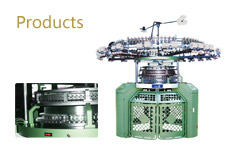Contact Us
Quanzhou luojiang donghui machinery co., ltd.
Add : Luojiang Shuangyang Industrial Zone, Quanzhou, Fujian Province, China
Tel : +86-595-22350156
Fax : +86-595-22350256
Industry News
Steps of the development and design of circular knitting fabric
Views:4185 Add Time:2013/3/25 16:58:17 From:
1: The development of the design knitting machine fabrics steps
Steps of the development and design of circular knitting fabric
(1) First, the design of the organizational structure and pattern of the fabric;
(2) to select and determine the kind of raw materials and specifications;
(3) to determine the physical indicators of the fabric;
(4) processing (preparation step of the knitting process, dyeing, finishing step);
(5) cost accounting;
(6) Develop a plan to test weaving samples.
2: development and design knitting machine fabric
(1) determine the organizational structure
Choose a different organizational structure for different uses, such as underwear soft, flexible, generally choose weft plain stitch, rib stitch;
(2) selection of raw materials:
Coat requires dimensional stability, no distortion, pregnant bone, pleasing in appearance, so it is necessary to select the chemical fiber; underwear requirements soft, warm, often used in cotton yarn and other raw materials.
(3) determine the physical indicators:
Generally weight, width, density, color fastness, shrinkage.
Little experience, for reference!
3: acetate silk fabric (YC)
Cellulose acetate silk like sheen and unique properties, drape and feel good. Using its production of knitted fabrics feel silky, comfortable to wear, moisture permeability, light texture and low moisture regain, not easy pilling, anti-static. Through careful dyed fabric is more prominent. Staining points: process: wool fabric inspection → slitting scheduled → dyeing → → → shaping → cooling soft handling → drying → packaging and storage.
Description:
Wool fabric weaving workshop over, to be tested in order to distinguish between the responsibilities; cloth inspection after the fabric relaxation, parking for 24 h, and then the cross-sectional width.
Predetermined shape, the temperature was controlled at 180 to 185 ° C Width than the finished width of about 10%, thus ensuring finished fabric formation, dimensionally stable.
Staining including the pre-treatment, and then add the softener.
The drying using 145 ° C in an oven at 1 to 2 for unpacking cooling, and then amorphous, cooling, packaging and storage.
Mode of operation:
The water is heated to 40 ℃, into the fabric and cleaning agent, wash away the stains on the fabric. Then add all the dyes and auxiliaries.
About 40 ℃, dyes and additives added to the speed of 1.5 ℃ / min rapid raw temperature to 86 ~ 90 ℃, temperature, light-colored insulation 30min dark insulation 45 to 60min.
After incubation, the cooling speed of from 1.5 to 2.0 ° C / min to 60 ℃, subjected to reduction cleaning.
Staining:
Adjust the PH value acetate, light-colored, was 5.5, dark is 4.5 to 5.0;
1 ~ 3g / L JHB-type softener;
Added by color, low temperature disperse dyes ET;
Reduction cleaning: Na2CO3 1 ~ 2g / L; Sodium Sulfate 0.5 ~ 1.0g / L;
Temperature of 85 ℃ ~ 90 ℃; time 10 ~~ 20min.
Using new materials and a new organizational structure, development and design of knitted fabrics, is the inevitable trend of market demand; only way to improve the technological content of products and value-added products, the product will get the favor of consumers, hope my colleagues more than the development of a novel of knitted fabrics, contribution to consumers.
Steps of the development and design of circular knitting fabric
(1) First, the design of the organizational structure and pattern of the fabric;
(2) to select and determine the kind of raw materials and specifications;
(3) to determine the physical indicators of the fabric;
(4) processing (preparation step of the knitting process, dyeing, finishing step);
(5) cost accounting;
(6) Develop a plan to test weaving samples.
2: development and design knitting machine fabric
(1) determine the organizational structure
Choose a different organizational structure for different uses, such as underwear soft, flexible, generally choose weft plain stitch, rib stitch;
(2) selection of raw materials:
Coat requires dimensional stability, no distortion, pregnant bone, pleasing in appearance, so it is necessary to select the chemical fiber; underwear requirements soft, warm, often used in cotton yarn and other raw materials.
(3) determine the physical indicators:
Generally weight, width, density, color fastness, shrinkage.
Little experience, for reference!
3: acetate silk fabric (YC)
Cellulose acetate silk like sheen and unique properties, drape and feel good. Using its production of knitted fabrics feel silky, comfortable to wear, moisture permeability, light texture and low moisture regain, not easy pilling, anti-static. Through careful dyed fabric is more prominent. Staining points: process: wool fabric inspection → slitting scheduled → dyeing → → → shaping → cooling soft handling → drying → packaging and storage.
Description:
Wool fabric weaving workshop over, to be tested in order to distinguish between the responsibilities; cloth inspection after the fabric relaxation, parking for 24 h, and then the cross-sectional width.
Predetermined shape, the temperature was controlled at 180 to 185 ° C Width than the finished width of about 10%, thus ensuring finished fabric formation, dimensionally stable.
Staining including the pre-treatment, and then add the softener.
The drying using 145 ° C in an oven at 1 to 2 for unpacking cooling, and then amorphous, cooling, packaging and storage.
Mode of operation:
The water is heated to 40 ℃, into the fabric and cleaning agent, wash away the stains on the fabric. Then add all the dyes and auxiliaries.
About 40 ℃, dyes and additives added to the speed of 1.5 ℃ / min rapid raw temperature to 86 ~ 90 ℃, temperature, light-colored insulation 30min dark insulation 45 to 60min.
After incubation, the cooling speed of from 1.5 to 2.0 ° C / min to 60 ℃, subjected to reduction cleaning.
Staining:
Adjust the PH value acetate, light-colored, was 5.5, dark is 4.5 to 5.0;
1 ~ 3g / L JHB-type softener;
Added by color, low temperature disperse dyes ET;
Reduction cleaning: Na2CO3 1 ~ 2g / L; Sodium Sulfate 0.5 ~ 1.0g / L;
Temperature of 85 ℃ ~ 90 ℃; time 10 ~~ 20min.
Using new materials and a new organizational structure, development and design of knitted fabrics, is the inevitable trend of market demand; only way to improve the technological content of products and value-added products, the product will get the favor of consumers, hope my colleagues more than the development of a novel of knitted fabrics, contribution to consumers.
Related Information


